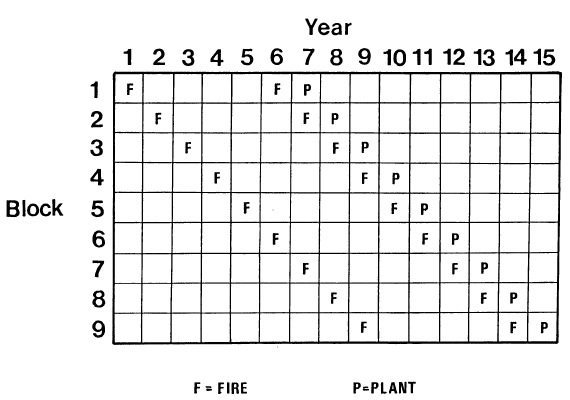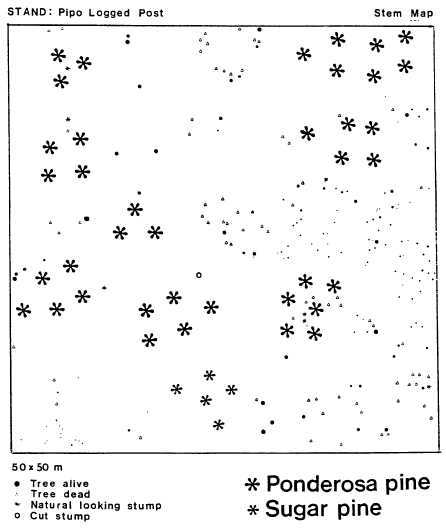Final Report, Forest Restoration of Sun Creek, Crater Lake National Park
Management Recommendations
Understocked Ponderosa Pine Areas
The Short Run
This area is now dominated by white fir in all size classes. The short-term goal in this area is to initiate regeneration of ponderosa pine while reducing the density of white fir. This can be accomplished with a combination of tree removal by saw or fire plus planting of pines. Much of the white fir to be removed is not of commercial size; cutting the smaller material would be very expensive and its disposal would be a problem. Although the area is laced with existing old skid trails and haul roads, a manual operation does not appear feasible.
If fire is used, the fuel creation problem caused by manual removal is avoided. However, the larger post-suppression white fir will not be removed by the intensities of fires proposed below. This will result in a continued dominance of white fir for at least the next “forest cycle” in this area. This may well be the cost associated with using a natural disturbance agent, fire, for a silvicultural treatment for which it is not perfectly suited. Fire thins from below, and to thin the larger size classes significantly will require fire behavior bordering on erratic, or a more selective manual removal. The timeframe for these treatments is a function of continued white fir occupation of growing space. Each year’s delay, while seemingly insignificant, makes the eventual treatment more difficult. The initial treatment should have been done forty years ago. We recommend completing all prescribed fire and planting treatments within the next fifteen years.
Prescribed fire treatments. The proposed short run treatment in this area is two prescribed fires over a period of 5 years, with subsequent planting of native ponderosa pines in selected areas. Protection of planted areas for 20 years is recommended, followed by recurrent prescribed fires with the pre-disturbance ranges of fire frequency and intensity.
The number of acres treated per year depends on the number of blocks and the number of years. If, for example, 9 blocks are chosen over a 15-year period (Table 5), then about 40 ha (100 acres) per year would be treated. This could be done in a single area or spread out over several smaller blocks of the understocked area.
The two prescribed fires will: (1) reduce white fir density over the area, (2) reduce long-term fuel accumulations and much of the dead fuel created by the first fire, and (3) reduce shrub density and biomass. Opening the area will create growing space for ponderosa pine and result in manageable fuel loads in the area after the 20 year protection period.
Planting. In the understocked area, the major species removed by logging was ponderosa pine. There was very little sugar pine in this area and white fir was not removed. Therefore, ponderosa pine is the major species that needs to be considered for planting; minor amounts of sugar pine will be needed.
Planting stock should be obtained from local seed sources of both species. Due to the potential variability of ponderosa in the area and its potential hybridization with Jeffrey pine, all seed collection should be restricted to the Sun Creek area of the park. Cones should be selected to include genetic variability at the site: good and poor form, limbing and limbless boles, a range of bark colors, etc. Good seed years occur on the average every 2-3 years, and several years’ worth of seed can be collected in one good seed year, if properly stored.
Seedling production can be contracted to local nurseries. Because of the importance of good initial growth, large planting stock (2-0 or 2-1 stock) should be requested. This means that the seed must enter the production schedule at least two years before planting occurs.
Planting at relatively low stocking is recommended. Although about 50-60 mature trees per ha (20-25 per acre) are desired, mortality due to planting shock, drought, animal damage, and subsequent fires requires higher planting densities. Planting densities of 170 per ha (70 per acre) are suggested, which would require about 7000 seedlings per year from the nursery (assuming a 15 year plan).
Since both the sugar and ponderosa pine are dispersed, they should be planted in pure clusters. In any area, there will usually be mature white fir clusters around or between which the pine clusters can be planted. Planted clusters should be centered in open areas, with spacing varying from a modified 3 x 3 m (10 x 10 ft) to 5 x 5 m (17 x 17 ft). If the entire hectare were planted in a uniform pattern with 170 trees, spacing would instead be about 7.5 x 7.5 m (25 x 25 ft), so the intent is to cluster seedlings in groups without crowding them within a group. Nine of every ten planted clusters should be ponderosa pine (Figure 12). Since our tree pattern data did not produce pattern size estimates, these spacings are an educated guess. The eventual pattern will be a result of seedling survival and subsequent fire effects.
The best planting time is usually April and May, just as soon as the snow melts and while soils are still moist. Planting after June 1 almost guarantees substantial seedling mortality. Even though the sites have been prepared by two prescribed fires, seedling planting sites should be scalped (clearing away litter, duff, and especially grass/sedge tops and roots). Proper planting is essential: digging a proper hole, preventing turned roots, and proper repacking of the hole with moist soil. Several good manuals (Schubert and Adams, 1971, Cleary et al, 1978) with planting guidelines are available for specific techniques.
Once each area has been burned twice and planted, a period of protection against fire will be needed. The time interval will depend upon tree height growth rates, the buildup of other fuels on the site, and the intended fire intensity of the next fire. A 20-year protection period should allow trees to reach about 6 m (20 ft) height. A low intensity fire (< 50 kcal/m/sec or 60 Btu/sec/ft) with little to no wind should scorch less than 50 percent of the tree height and reduce much of the competing vegetation. At that point, long-term strategies for natural fire maintenance should be considered.
The Long Run
The long run consequences of no treatment, exclusive use of fire, and use of fire plus planting are shown in Figure 13. Under “A. Log/Fire Exclusion” the failure of pine to regenerate after logging will continue, resulting in a relatively pure white fir forest. Under “B. Log/Reintroduce Fire,” sufficient growing space for pine is created, but the absence of seed source results in essentially the same relative forest structure over time as “A.” The proposed plan is shown under “C. Log/Reintroduce Fire/Plant.” Through a continued selective favoring by fire of planted pines, they will eventually dominate the overstory and be adequately represented in the understory.
One potential problem with the proposed planting scheme is that planted seedlings will be even-aged in clusters within the logged areas. There is no clear evidence that this occurred in the pre-fire suppression era; our plot data did not conclusively show any single or nearby groups of clusters to be even-aged. However, even if somewhat unnatural in terms of age structure, it will visually be a mimic of natural structure, Maintenance of periodic fire over a generation of trees should complete the restoration process.
***previous*** — ***next***



